Why you can trust Tom's Hardware
To learn more about our PSU tests and methodology, please check out How We Test Power Supply Units.
Primary Rails And 5VSB Load Regulation
The following charts show the main rails' voltage values recorded between a range of 40W up to the PSU's maximum specified load, along with the deviation (in percent). Tight regulation is an important consideration every time we review a power supply because it facilitates constant voltage levels despite varying loads. Tight load regulation also, among other factors, improves the system’s stability, especially under overclocked conditions and, at the same time, it applies less stress to the DC-DC converters that many system components utilize.

Results 1-8: Load Regulation







The load regulation at +12V is not tight enough, while on the minor rails, it is satisfactory.
Hold-Up Time
Put simply; hold-up time is the amount of time that the system can continue to run without shutting down or rebooting during a power interruption.
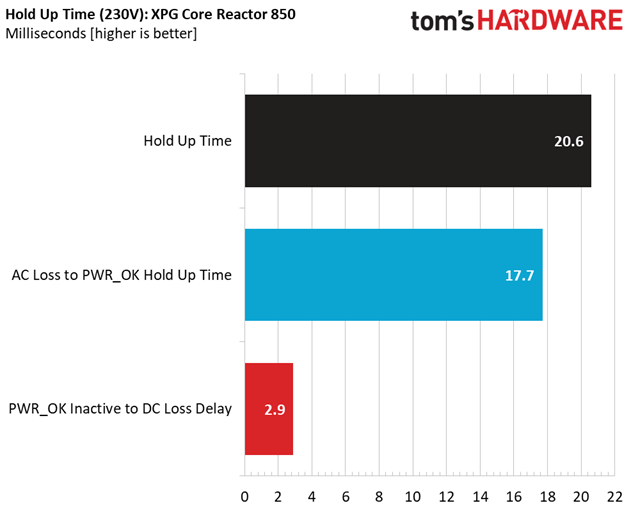
Results 9-12: Hold-Up Time






The hold-up time is longer than 20ms and the power-ok signal is accurate.
Inrush Current
Inrush current, or switch-on surge, refers to the maximum, instantaneous input current drawn by an electrical device when it is first turned on. A large enough inrush current can cause circuit breakers and fuses to trip. It can also damage switches, relays, and bridge rectifiers. As a result, the lower the inrush current of a PSU right as it is turned on, the better.

Results 13-14: Inrush Current
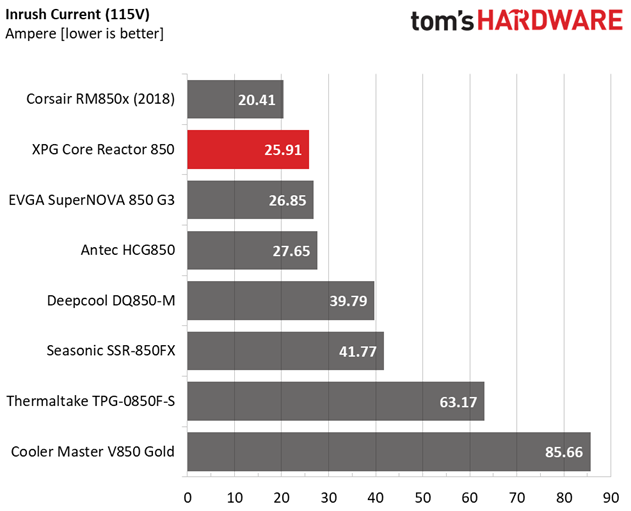
The inrush currents are at low enough levels, with both voltage inputs.
Get Tom's Hardware's best news and in-depth reviews, straight to your inbox.
10-110% Load Tests
These tests reveal the PSU's load regulation and efficiency levels under high ambient temperatures. They also show how the fan speed profile behaves under increased operating temperatures.
| Test # | 12V | 5V | 3.3V | 5VSB | DC/AC (Watts) | Efficiency | Fan Speed (RPM) | PSU Noise (dB[A]) | Temps (In/Out) | PF/AC Volts |
| 1 | 5.191A | 1.980A | 1.994A | 0.994A | 84.957 | 86.339% | 637 | 9.3 | 40.25°C | 0.978 |
| 12.203V | 5.052V | 3.312V | 5.034V | 98.399 | 45.29°C | 115.14V | ||||
| 2 | 11.502A | 2.972A | 2.990A | 1.194A | 170.028 | 90.579% | 640 | 9.4 | 40.41°C | 0.987 |
| 12.096V | 5.048V | 3.309V | 5.027V | 187.713 | 46.01°C | 115.13V | ||||
| 3 | 18.117A | 3.469A | 3.493A | 1.395A | 255.037 | 91.675% | 643 | 9.4 | 41.22°C | 0.990 |
| 12.087V | 5.045V | 3.307V | 5.021V | 278.196 | 47.00°C | 115.13V | ||||
| 4 | 24.708A | 3.966A | 3.993A | 1.596A | 340.048 | 91.571% | 648 | 9.6 | 41.73°C | 0.988 |
| 12.095V | 5.043V | 3.306V | 5.015V | 371.349 | 48.14°C | 115.12V | ||||
| 5 | 30.800A | 4.960A | 4.995A | 1.797A | 424.965 | 91.082% | 975 | 20.5 | 42.65°C | 0.989 |
| 12.158V | 5.039V | 3.304V | 5.009V | 466.574 | 49.70°C | 115.12V | ||||
| 6 | 36.990A | 5.960A | 5.999A | 2.000A | 509.511 | 90.168% | 1472 | 32.2 | 42.79°C | 0.991 |
| 12.157V | 5.036V | 3.301V | 5.003V | 565.070 | 50.45°C | 115.11V | ||||
| 7 | 43.268A | 6.958A | 7.006A | 2.202A | 594.870 | 89.500% | 1797 | 39.0 | 42.97°C | 0.992 |
| 12.151V | 5.032V | 3.298V | 4.996V | 664.656 | 51.03°C | 115.11V | ||||
| 8 | 49.542A | 7.959A | 8.009A | 2.406A | 680.206 | 88.747% | 2073 | 42.6 | 43.60°C | 0.993 |
| 12.147V | 5.028V | 3.296V | 4.989V | 766.457 | 52.74°C | 115.13V | ||||
| 9 | 56.215A | 8.460A | 8.500A | 2.407A | 765.133 | 88.069% | 2266 | 44.7 | 44.77°C | 0.994 |
| 12.143V | 5.025V | 3.294V | 4.987V | 868.787 | 54.78°C | 115.15V | ||||
| 10 | 62.636A | 8.963A | 9.023A | 3.019A | 849.988 | 87.280% | 2290 | 45.7 | 44.79°C | 0.995 |
| 12.138V | 5.021V | 3.292V | 4.970V | 973.864 | 55.67°C | 115.13V | ||||
| 11 | 69.619A | 8.967A | 9.025A | 3.020A | 934.754 | 86.524% | 2286 | 45.6 | 46.54°C | 0.995 |
| 12.138V | 5.020V | 3.291V | 4.968V | 1080.336 | 57.86°C | 115.14V | ||||
| CL1 | 0.117A | 14.002A | 14.000A | 0.000A | 118.188 | 84.109% | 663 | 10.2 | 42.76°C | 0.985 |
| 12.118V | 5.040V | 3.300V | 5.069V | 140.517 | 49.51°C | 115.16V | ||||
| CL2 | 70.846A | 0.999A | 1.001A | 1.000A | 872.992 | 87.771% | 2170 | 43.6 | 44.93°C | 0.995 |
| 12.134V | 5.033V | 3.301V | 5.015V | 994.627 | 55.47°C | 115.14V |
The +12V rail's voltage goes up and down instead of a linear decrease as the load increases. This has to do mostly with the resonant controller.
The fan profile with higher than typical loads should be looser, even if CWT had to make some changes on the platform and use proper heat sinks on the secondary side.
20-80W Load Tests
In the following tests, we measure the PSU's efficiency at loads significantly lower than 10% of its maximum capacity (the lowest load the 80 PLUS standard measures). This is important for representing when a PC is idle with power-saving features turned on.
| Test # | 12V | 5V | 3.3V | 5VSB | DC/AC (Watts) | Efficiency | Fan Speed (RPM) | PSU Noise (dB[A]) | PF/AC Volts |
| 1 | 1.236A | 0.495A | 0.497A | 0.198A | 19.987 | 75.982% | 623 | 9.0 | 0.842 |
| 12.004V | 5.055V | 3.314V | 5.053V | 26.305 | 115.14V | ||||
| 2 | 2.470A | 0.990A | 0.997A | 0.396A | 39.976 | 82.044% | 628 | 9.1 | 0.940 |
| 12.013V | 5.053V | 3.313V | 5.047V | 48.725 | 115.14V | ||||
| 3 | 3.652A | 1.485A | 1.495A | 0.595A | 60.007 | 84.265% | 631 | 9.1 | 0.961 |
| 12.199V | 5.053V | 3.312V | 5.043V | 71.212 | 115.14V | ||||
| 4 | 4.865A | 1.980A | 1.993A | 0.794A | 79.956 | 86.079% | 633 | 9.2 | 0.977 |
| 12.200V | 5.052V | 3.312V | 5.038V | 92.887 | 115.14V |
The efficiency at light loads is excellent!
2% or 10W Load Test
Intel plans on raising the ante at efficiency levels under ultra-light loads. So from July 2020, the ATX spec will require 70% and higher efficiency with 115V input. The applied load is only 10W for PSUs with 500W and lower capacities, while for stronger units we dial 2% of their max-rated-capacity.
| Test # | 12V | 5V | 3.3V | 5VSB | DC/AC (Watts) | Efficiency | Fan Speed (RPM) | PSU Noise (dB[A]) | PF/AC Volts |
| 1 | 1.224A | 0.249A | 0.249A | 0.052A | 17.015 | 73.843% | 755 | 12.9 | 0.804 |
| 11.985V | 5.050V | 3.311V | 5.051V | 23.042 | 115.11V |
Thanks to the new Champion resonant controller and its burst mode operation, the efficiency at super light loads easily exceeds 70%.
Efficiency
Next, we plotted a chart showing the PSU’s efficiency at low loads, and loads from 10 to 110% of its maximum-rated capacity. The higher a PSU’s efficiency, the less energy goes wasted, leading to a reduced carbon footprint and lower electricity bills.

Results 15-18: Efficiency


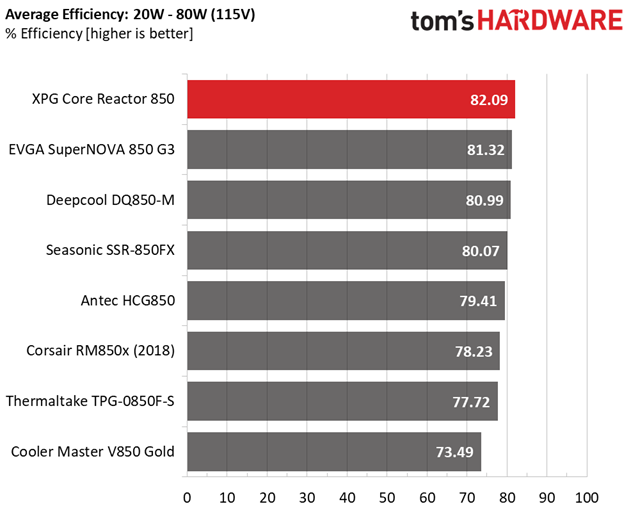
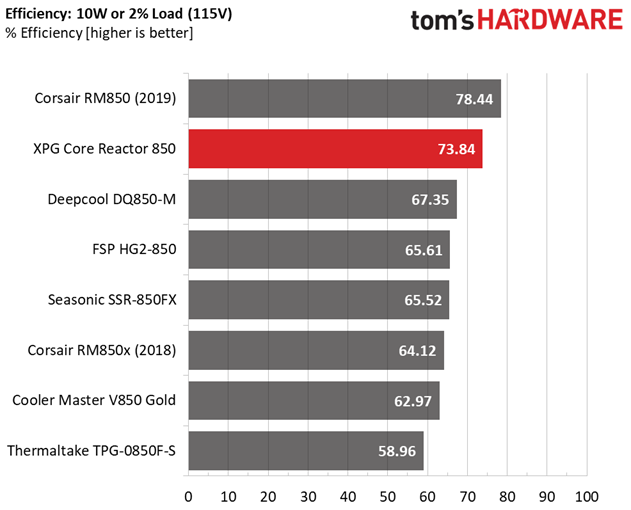
This is a highly efficient power supply, especially under light and super-light loads.
5VSB Efficiency
| Test # | 5VSB | DC/AC (Watts) | Efficiency | PF/AC Volts |
| 1 | 0.100A | 0.505 | 76.982% | 0.066 |
| 5.054V | 0.656 | 115.17V | ||
| 2 | 0.250A | 1.263 | 79.135% | 0.148 |
| 5.050V | 1.596 | 115.17V | ||
| 3 | 0.550A | 2.774 | 79.850% | 0.264 |
| 5.042V | 3.474 | 115.17V | ||
| 4 | 1.000A | 5.032 | 79.570% | 0.358 |
| 5.030V | 6.324 | 115.17V | ||
| 5 | 1.500A | 7.528 | 79.518% | 0.412 |
| 5.017V | 9.467 | 115.17V | ||
| 6 | 3.000A | 14.933 | 78.167% | 0.478 |
| 4.977V | 19.104 | 115.17V |
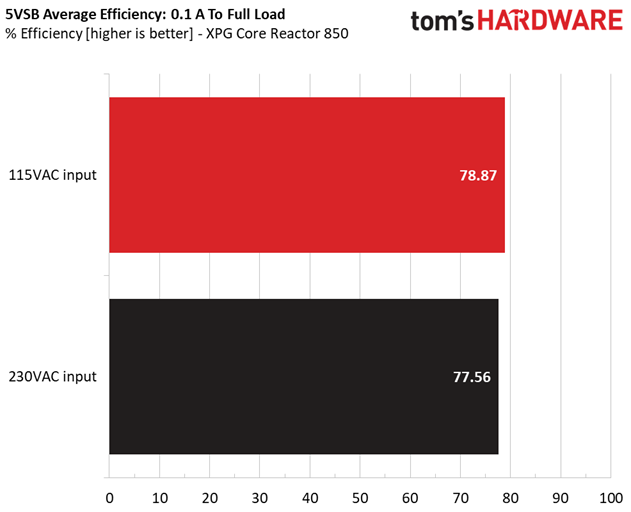
Results 19-20: 5VSB Efficiency

The 5VSB rail is also highly efficient.
Power Consumption In Idle And Standby
| Mode | 12V | 5V | 3.3V | 5VSB | Watts | PF/AC Volts |
| Idle | 11.973V | 5.047V | 3.308V | 5.048V | 3.306 | 0.257 |
| 115.1V | ||||||
| Standby | 0.034 | 0.003 | ||||
| 115.1V |

Results 21-22: Vampire Power
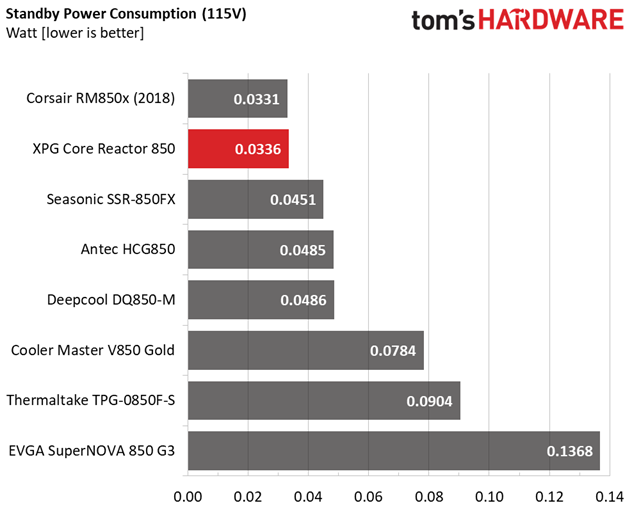
The vampire power levels are restricted with both voltage inputs.
Fan RPM, Delta Temperature, And Output Noise
All results are obtained between an ambient temperature of 37 to 47 degrees Celsius (98.6 to 116.6 degrees Fahrenheit).
The fan profile should be more relaxed, under higher loads at increased operating temperatures. The overall output noise output of our sample is notably higher compared to the Cybenetics results, and this is an indication that the standard production batches use a different fan speed profile (Cybenetics usually tests pre-production samples).
The following results were obtained at 30 to 32 degrees Celsius (86 to 89.6 degrees Fahrenheit) ambient temperature.
Up to typical loads (around 420W), the fan spins at its lowest speed, where it is inaudible. With about 130W more, though, it exceeds 30 dB(A), and with more than 740W, the noise goes over 40 dB(A).
MORE: Best Power Supplies
MORE: How We Test Power Supplies
MORE: All Power Supply Content
Current page: Load Regulation, Hold-Up Time, Inrush Current, Efficiency and Noise
Prev Page Specifications and Part Analysis Next Page Protection Features, DC Power Sequencing, Cross-Load Tests and Infrared Images
Aris Mpitziopoulos is a contributing editor at Tom's Hardware, covering PSUs.
-
Olle P Hardware-wise this seems like a great PSU.Reply
One good thing that wasn't listed is that the housing actually adhere to the ATX-format! (Most PSUs have the wrong length.) -
Darkbreeze There are no standards for depth on ATX power supplies. They vary from model to model and it has been that way since forever. Even within the same brand. This is nothing new. There is no ATX format regarding depth for it to adhere TO.Reply
Aris. Any idea yet whether all three capacities of this power supply are using the same platform and have the same expected or similar performance and characteristics or no idea at this time? Thanks. -
Yeca I got one of this recently for a new build, and being the paranoic person that i am, i bought a psu tester and it showed a 80ms PG result. The 12V, 5V and 3.3V results were alright. Is this something i should worry about?Reply -
Yeca Reply
Got it, thanks!Darkbreeze said:You should start your own thread. This is not the place for such questions.






